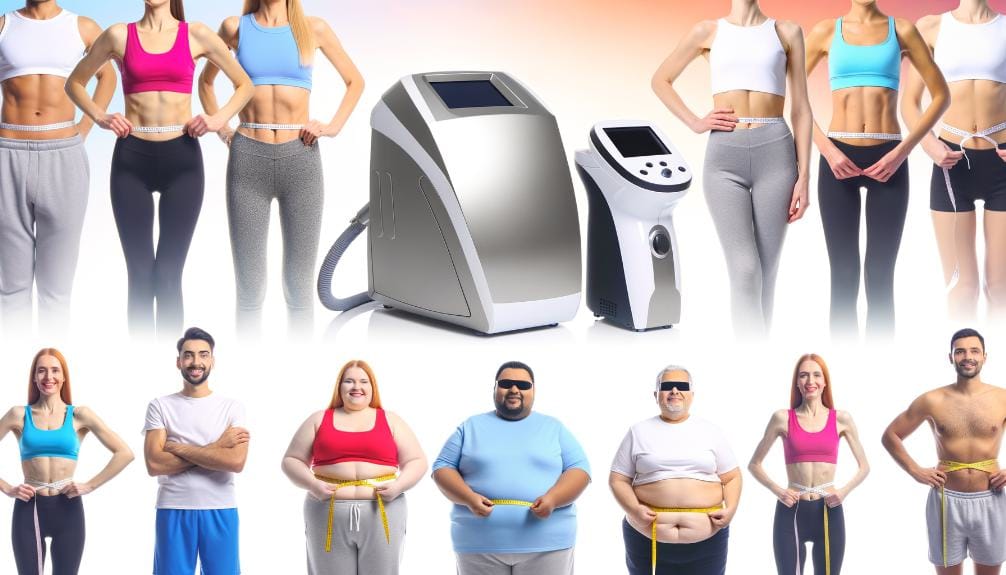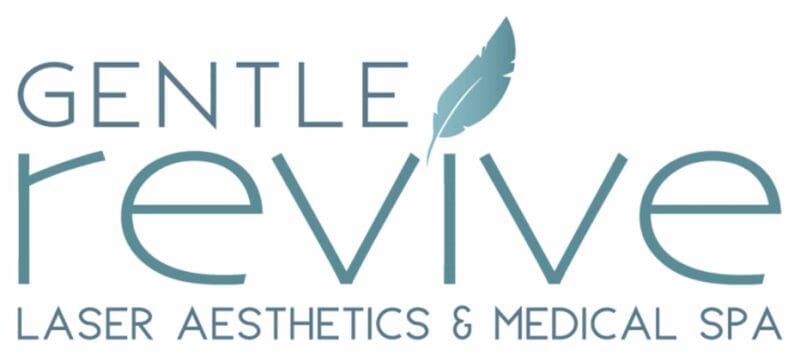
Just as Icarus sought to reshape his destiny through innovation, we're on the brink of transforming body contouring with the latest non-invasive fat reduction trends in 2023.
We've witnessed remarkable advancements in cryolipolysis, ultrasound techniques, and radiofrequency innovations, each offering a unique pathway to achieving desired aesthetic outcomes without the need for surgical intervention.
Our exploration doesn't stop there; developments in laser lipolysis, high-intensity focused ultrasound (HIFU), and emerging technologies promise to redefine what's possible.
Join us as we uncover the potential of these cutting-edge treatments to sculpt the future of cosmetic procedures, leaving traditional methods in the past.
Cryolipolysis Breakthroughs
We've observed notable advancements in cryolipolysis technology, enhancing its efficacy and patient comfort in non-invasive fat reduction. This method, fundamentally relying on controlled cooling to target and eliminate fat cells without damage to surrounding tissues, has evolved. Recent developments have introduced more precise temperature controls, greatly reducing the risk of adverse effects and improving the predictability of outcomes. These improvements have made treatments more comfortable for patients, with fewer reports of discomfort during and post-procedure.
Additionally, advancements in applicator design have broadened the treatable areas, allowing practitioners to target fat deposits more accurately. This precision has opened the door to treating smaller, more challenging areas, offering a tailored approach to fat reduction that wasn't previously possible.
We've also witnessed a reduction in treatment time due to these technological advancements. Enhanced cooling mechanisms have expedited the process, making it more convenient for patients seeking effective fat reduction without the downtime associated with traditional methods.
Enhanced Ultrasound Techniques
Shifting focus to enhanced ultrasound techniques, recent innovations have greatly advanced the precision and effectiveness of non-invasive fat reduction. We've observed a remarkable evolution in ultrasound technology, leading to highly targeted fat cell disruption without affecting the surrounding tissues. This importance is vital in minimizing side effects and enhancing patient comfort during the procedure.
The latest advancements incorporate high-intensity focused ultrasound (HIFU) technology, which precisely targets fat cells at specific depths beneath the skin. This method guarantees only the fat cells are destroyed, and the body naturally eliminates them over time. The precision of HIFU also means treatments can be customized to the individual's needs, offering personalized fat reduction solutions.
We've also seen the integration of imaging techniques with ultrasound, allowing for real-time visualization of the treatment area. This advancement not only increases the safety profile by ensuring accurate targeting but also optimizes the outcome by allowing adjustments in real-time based on the fat distribution and density observed.
Radiofrequency Innovations
Building on the advancements in ultrasound technology, the field of non-invasive fat reduction has also seen significant progress with the introduction of innovative radiofrequency techniques. These cutting-edge methods leverage electromagnetic waves to heat the fat cells under the skin without affecting the surrounding tissues. This targeted approach causes the fat cells to metabolize and shrink, offering a safer, more efficient alternative to traditional fat reduction methods.
We've observed a significant leap in the precision of these techniques, allowing for more focused treatment areas and minimizing the risk of damage to adjacent tissues. The advancements in radiofrequency technology have also shortened treatment times and enhanced patient comfort, making it a highly sought-after option for those looking to reduce stubborn fat deposits without the downtime associated with surgical procedures.
Additionally, the latest radiofrequency innovations have introduced improvements in skin tightening, further enhancing the aesthetic outcomes of fat reduction treatments. By stimulating collagen production, these methods not only reduce fat but also improve skin texture and elasticity, offering a dual benefit to patients.
As leaders in the field, we continue to explore and refine radiofrequency techniques, ensuring they remain at the forefront of non-invasive body contouring options. These innovations represent a pivotal shift in how we approach fat reduction, prioritizing safety, efficacy, and patient satisfaction.
Laser Lipolysis Developments
In recent years, laser lipolysis has emerged as a groundbreaking approach, frequently revolutionizing the landscape of non-invasive fat reduction with its precision and efficiency. This technique leverages targeted laser energy to disrupt fat cells, causing them to break down and be naturally expelled by the body. We've observed significant advancements in the technology, enhancing its safety profile and reducing recovery times, making it an increasingly popular choice for those seeking fat reduction without the invasiveness of traditional liposuction.
Our research indicates that the latest developments in laser lipolysis focus on optimizing wavelength selection and energy delivery methods to maximize fat cell destruction while preserving surrounding tissues. This specificity not only improves the effectiveness of the procedure but also minimizes potential side effects, such as discomfort and swelling. Additionally, we've seen a trend towards combining laser lipolysis with other non-invasive techniques to enhance overall outcomes.
As we continue to explore and refine laser lipolysis, it's clear that this method stands at the forefront of non-invasive fat reduction. Its ability to target and eliminate fat cells with such precision marks a significant leap forward in our quest for safer, more effective body contouring solutions.
High-Intensity Focused Ultrasound (HIFU)
While laser lipolysis has greatly progressed non-invasive fat reduction, High-Intensity Focused Ultrasound (HIFU) emerges as another innovative technique, offering unique benefits in targeting adipose tissue. We've observed HIFU's ability to precisely target deeper layers of fat without damaging the skin or surrounding tissues, a significant advantage for clients seeking targeted fat reduction.
HIFU works by delivering focused ultrasound energy to heat the adipose tissue at specific depths, causing cellular disruption and apoptosis in fat cells. This process leads to a gradual reduction in fat layer thickness, with results becoming visible over several weeks as the body naturally metabolizes the treated fat cells. We appreciate HIFU's versatility, as it can be applied to various body areas, including the abdomen, thighs, and under the chin, providing a tailored approach to fat reduction.
Our analysis confirms that HIFU treatments are generally well tolerated, with minimal to no downtime required. This aspect is particularly appealing to clients seeking effective fat reduction solutions without the recovery period associated with more invasive procedures. Moreover, we've noted an increase in client satisfaction rates, attributing this to HIFU's ability to achieve noticeable, natural-looking results through a non-invasive approach.
Electromagnetic Muscle Stimulation
Shifting from the thermal effects of HIFU, we now explore Electromagnetic Muscle Stimulation (EMS), a groundbreaking approach that leverages electromagnetic fields to induce muscle contractions and promote fat loss. Unlike traditional methods that target fat directly, EMS focuses on enhancing muscle tone and strength, indirectly contributing to a more sculpted physique. This technology stimulates muscles far beyond what's possible through conventional exercise, generating thousands of contractions in a single session, a feat unachievable through voluntary workouts.
We've observed that EMS not only aids in reducing fat but also notably improves metabolic rates. The induced muscle activity requires energy, which the body derives from fat stores, thereby accelerating fat reduction. Additionally, the process of muscle building and repair, triggered by these intense contractions, continues to burn calories long after the session, enhancing long-term metabolic efficiency.
Our analysis indicates that EMS is particularly effective for individuals seeking to enhance muscle definition while reducing fat in targeted areas. Its non-invasive nature, coupled with the absence of downtime, positions it as a preferable option for those seeking efficient, visible results without the risks associated with surgical procedures.
Red Light Therapy Advancements
Progressing beyond traditional methodologies, we now explore the remarkable advancements in Red Light Therapy, a technique that utilizes specific wavelengths of light to penetrate the skin and target fat cells directly. Recent innovations in this domain have greatly enhanced its efficacy, offering a promising avenue for non-invasive fat reduction. By employing wavelengths in the 630-670 nanometer range, Red Light Therapy works by stimulating mitochondrial activity within the adipocytes, thereby promoting lipolysis - the breakdown of fat cells.
We've observed a substantial improvement in the precision of light delivery systems, ensuring deeper and more uniform exposure to the targeted areas. This advancement not only maximizes the treatment's effectiveness but also reduces the duration of each session, making it more convenient for individuals seeking fat reduction solutions.
The integration of cooling mechanisms has revolutionized the patient experience, minimizing discomfort and potential side effects associated with the therapy. These technological enhancements, combined with rigorous clinical research, have solidified Red Light Therapy's position as a leading non-invasive fat reduction trend in 2023.
Injectable Lipolysis Progress
How has injectable lipolysis evolved to become a cornerstone in the domain of non-invasive fat reduction? Initially, this method was perceived with skepticism due to its invasive nature. However, advancements in the formulation and delivery mechanisms have revolutionized its application, making it a highly sought-after procedure for targeted fat loss. We've observed a significant leap in its efficacy and safety profile, attributed to the meticulous research and development efforts that have honed the substances used—primarily deoxycholic acid.
This compound, when injected, effectively disrupts fat cell membranes, leading to their breakdown and subsequent natural elimination from the body. What sets injectable lipolysis apart in 2023 is the precision with which it can target adipose tissue, allowing for sculpted results without the need for surgical intervention. Furthermore, we've seen a reduction in side effects, with most patients experiencing minimal discomfort and downtime.
This progress underscores a pivotal shift towards more accessible and less invasive fat reduction options, aligning with the growing demand for procedures that don't require significant recovery periods. Our ongoing research aims to further refine these techniques, ensuring safer, more effective outcomes for individuals seeking non-surgical body contouring solutions.
Vacuum-Assisted Technology
Vacuum-assisted technology has emerged as a pivotal innovation in non-invasive fat reduction, offering a sophisticated method to precisely target and eliminate adipose tissue without surgical intervention. This technique leverages controlled suction to isolate fat deposits, enhancing the efficiency of various energy-based devices in fat reduction. We've observed a significant advancement in this technology, focusing on minimizing discomfort and maximizing fat elimination with minimal side effects.
Our analysis reveals that vacuum-assisted technology optimizes the delivery of thermal or cooling energies to the adipose layer, ensuring uniform treatment and reducing the risk of irregularities post-treatment. This precision is important for patient satisfaction and treatment efficacy. Additionally, the integration of real-time monitoring systems within these devices allows for immediate adjustment of parameters, ensuring best outcomes while maintaining safety profiles.
The development of vacuum-assisted technology has marked a significant shift in the approach to body contouring. It's not only broadened the scope of treatable areas but also introduced a level of precision and safety previously unattainable with traditional methods. As we continue to explore its potential, vacuum-assisted technology stands as a proof to the rapidly evolving landscape of non-invasive aesthetic treatments, promising to redefine standards and expectations in fat reduction.
Dual-Modality Treatments
In the domain of non-invasive fat reduction, dual-modality treatments have emerged as a groundbreaking approach, combining different technologies to enhance fat elimination and skin tightening effects. We've observed that these innovative treatments leverage the synergistic effects of two distinct modalities, often utilizing a combination of radiofrequency and ultrasound or laser and cooling technologies. This strategy not only accelerates the breakdown of fat cells but also promotes collagen production, leading to both a reduction in fat and an improvement in skin texture and firmness.
Our analysis of the latest research and clinical trials reveals that dual-modality treatments offer a more thorough approach to body contouring. By addressing both fat reduction and skin laxity, we're able to achieve more pronounced and visually satisfying results for our patients. Additionally, these treatments tend to have shorter recovery times and lower risk profiles compared to traditional surgical methods, making them an attractive option for individuals seeking effective fat reduction without the downtime.
We're particularly excited about the potential these treatments hold for personalized care. By adjusting the intensity and combination of modalities, we can tailor treatments to meet the specific needs and desired outcomes of each patient, ensuring the most favorable results.
Conclusion
To sum up, we've delved into the forefront of non-invasive fat reduction trends in 2023, showcasing breakthroughs in cryolipolysis, enhanced ultrasound, radiofrequency, laser lipolysis, HIFU, red light therapy, injectable lipolysis, vacuum-assisted technology, and dual-modality treatments.
These advancements offer safer, more effective alternatives to traditional fat reduction methods, providing individuals with diverse options tailored to their specific needs.
We're committed to keeping abreast of these innovations, ensuring our recommendations remain scientifically sound and authoritative in the evolving landscape of cosmetic procedures.




© All Copyrights 2023-2024 by Utah Lipo & Body Sculpting








